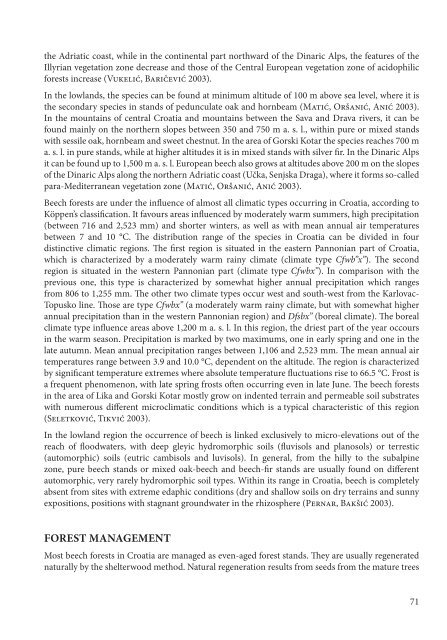Create successful ePaper yourself
Turn your PDF publications into a flip-book with our unique Google optimized e-Paper software.
the Adriatic coast, while in the continental part northward of the Dinaric Alps, the features of the<br />
Illyrian vegetation zone <strong>de</strong>crease and those of the Central European vegetation zone of acidophilic<br />
forests increase (Vukelić, Baričević 2003).<br />
In the lowlands, the species can be found at minimum altitu<strong>de</strong> of 100 m above sea level, where it is<br />
the secondary species in stands of pedunculate oak and hornbeam (Matić, Oršanić, Anić 2003).<br />
In the mountains of central Croatia and mountains between the Sava and Drava rivers, it can be<br />
found mainly on the northern slopes between 350 and 50 m a. s. l., within pure or mixed stands<br />
with sessile oak, hornbeam and sweet chestnut. In the area of Gorski Kotar the species reaches 00 m<br />
a. s. l. in pure stands, while at higher altitu<strong>de</strong>s it is in mixed stands with silver fir. In the Dinaric Alps<br />
it can be found up to 1,500 m a. s. l. European beech also grows at altitu<strong>de</strong>s above 200 m on the slopes<br />
of the Dinaric Alps along the northern Adriatic coast (Učka, Senjska Draga), where it forms so-called<br />
para-Mediterranean vegetation zone (Matić, Oršanić, Anić 2003).<br />
Beech forests are un<strong>de</strong>r the influence of almost all climatic types occurring in Croatia, according to<br />
Köppen’s classification. It favours areas influenced by mo<strong>de</strong>rately warm summers, high precipitation<br />
(between 16 and 2,<strong>52</strong>3 mm) and shorter winters, as well as with mean annual air temperatures<br />
between and 10 °C. The distribution range of the species in Croatia can be divi<strong>de</strong>d in four<br />
distinctive climatic regions. The first region is situated in the eastern Pannonian part of Croatia,<br />
which is characterized by a mo<strong>de</strong>rately warm rainy climate (climate type Cfwb”x”). The second<br />
region is situated in the western Pannonian part (climate type Cfwbx”). In comparison with the<br />
previous one, this type is characterized by somewhat higher annual precipitation which ranges<br />
from 806 to 1,255 mm. The other two climate types occur west and south-west from the Karlovac-<br />
Topusko line. Those are type Cfwbx” (a mo<strong>de</strong>rately warm rainy climate, but with somewhat higher<br />
annual precipitation than in the western Pannonian region) and Dfsbx” (boreal climate). The boreal<br />
climate type influence areas above 1,200 m a. s. l. In this region, the driest part of the year occours<br />
in the warm season. Precipitation is marked by two maximums, one in early spring and one in the<br />
late autumn. Mean annual precipitation ranges between 1,106 and 2,<strong>52</strong>3 mm. The mean annual air<br />
temperatures range between 3.9 and 10.0 °C, <strong>de</strong>pen<strong>de</strong>nt on the altitu<strong>de</strong>. The region is characterized<br />
by significant temperature extremes where absolute temperature fluctuations rise to 66.5 °C. Frost is<br />
a frequent phenomenon, with late spring frosts often occurring even in late June. The beech forests<br />
in the area of Lika and Gorski Kotar mostly grow on in<strong>de</strong>nted terrain and permeable soil substrates<br />
with numerous different microclimatic conditions which is a typical characteristic of this region<br />
(Seletković, Tikvić 2003).<br />
In the lowland region the occurrence of beech is linked exclusively to micro-elevations out of the<br />
reach of floodwaters, with <strong>de</strong>ep gleyic hydromorphic soils (fluvisols and planosols) or terrestic<br />
(automorphic) soils (eutric cambisols and luvisols). In general, from the hilly to the subalpine<br />
zone, pure beech stands or mixed oak-beech and beech-fir stands are usually found on different<br />
automorphic, very rarely hydromorphic soil types. Within its range in Croatia, beech is completely<br />
absent from sites with extreme edaphic conditions (dry and shallow soils on dry terrains and sunny<br />
expositions, positions with stagnant groundwater in the rhizosphere (Pernar, Bakšić 2003).<br />
ForesT maNaGemeNT<br />
Most beech forests in Croatia are managed as even-aged forest stands. They are usually regenerated<br />
naturally by the shelterwood method. Natural regeneration results from seeds from the mature trees<br />
1

















